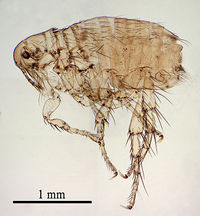Ctenocephalides canis
Also known as: Dog flea
| Ctenocephalides canis | |
|---|---|
| Class | Insecta |
| Order | Siphonaptera |
| Family | Pulicidae |
| Species | Ctenocephalides canis |
Hosts
Dogs, cats, rabbits, rats, foxes and humans
Identification
C. canis is very similar to C.felis, and of the order Siphonaptera. The first genal spine is 0.5 times the length of the second, and C. canis has a more rounded head than C. felis.
Life Cycle
Again, very similar to C. felis. The eggs are produced soon after arrival on the host. They then hatch into larvae, which undergo two moults before entering the pupae stage. The pupae may remain dormant for a year or longer, and are stimulated to hatch by mechanical stimuli such as vibrations.
Under suitable conditions, the complete life cycle can take as little as 3 weeks.
| Ctenocephalides canis Learning Resources | |
|---|---|
To reach the Vetstream content, please select |
Canis, Felis, Lapis or Equis |
 Search for recent publications via CAB Abstract (CABI log in required) |
Ctenocephalides canis publications |
Error in widget FBRecommend: unable to write file /var/www/wikivet.net/extensions/Widgets/compiled_templates/wrt6934d03a6b9709_60985787 Error in widget google+: unable to write file /var/www/wikivet.net/extensions/Widgets/compiled_templates/wrt6934d03a7183c4_73494658 Error in widget TwitterTweet: unable to write file /var/www/wikivet.net/extensions/Widgets/compiled_templates/wrt6934d03a781bf1_80034183
|
| WikiVet® Introduction - Help WikiVet - Report a Problem |
